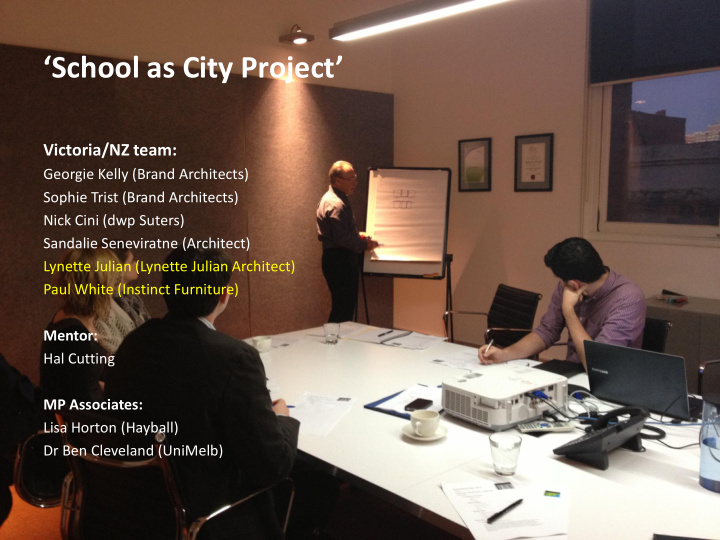



‘School as City Project’ Victoria/NZ team: Georgie Kelly (Brand Architects) Sophie Trist (Brand Architects) Nick Cini (dwp Suters) Sandalie Seneviratne (Architect) Lynette Julian (Lynette Julian Architect) Paul White (Instinct Furniture) Mentor: Hal Cutting MP Associates: Lisa Horton (Hayball) Dr Ben Cleveland (UniMelb)
‘School as City Project’ Research question: • What lessons learned from city planning and urban regeneration projects might inform the regeneration of ‘failing schools’? Research provocations/wonderings: • What if schools were open 24/7? • What if schools catered to people of all ages? • What if schools were sites of cultural diversity? • What if schools were hubs of creativity? • What if schools offered opportunities for serendipitous learning? • What if schools were microcosms of the city?
‘The Porous Campus: Community Engagement and the Design of the Contemporary School’
Heppell et al (2004) Scenario 1: ‘No physical school at all’ Scenario 2: ‘Dissolved Secondary School’ Scenario 3: ‘Extended School’ Scenario 4: ‘Fortress School’
Themes • Campus porosity – connectedness of school and community • Boundary dynamics – interactions between bounded groups • Social capital – influence of campus and facility design (level of porosity) on the development/regeneration of social capital in schools and local communities
Art Education/Mathematics Education Programs • Art Play • The Song Room • Melbourne Symphony Orchestra • Canstruction Case studies • Ivanhoe Girls Grammar • Ashwood College • Bayswater West Primary Image: free-things-to-do-in-mebourne.com School
Program Heath & Service • Men's Sheds Case study • Yuille Park P-8 Community College Learning Pod 6-8 Sports Court/ Performance Learning Pod 3-5 Learning Pod P-2 Library Early Childhood Agora Mens Shed School Entry Integration – Linking a Culture of Excellence with Community Aspirations & Expectations
Garden & Food Program • Stephanie Alexander Kitchen Garden Foundation Case studies • Collingwood College • Meadows Primary School Image: kitchengardenfoundation.com.au
Designing for Complexity Lynette Julian – Prepared for Mayfield Project 2013/14
References • Beare, H. (2000a). Creating the future school ., London: Routledge Falmer. • Beare , H. (2000b). The future? You’re standing in it! A design and technology perspective on the future of schooling in the Information Age. Australian Council of Education through Technology 2000 Conference, Downer, ACT. • Heppell, S., Chapman, C., Millwood, R., Constable, M. & Furness, J. (2004). Building learning futures. Building Futures. www.buildingfutures.org.uk • Rudd, T., Gifford, C., Morrison, J., & Facer, K. (2006). What if ... re- imagining learning spaces. Bristol: Futurelab. • Upitis, R. (2004). School architecture and complexity. Complicity: An International Journal of Complexity and Education., 1 (1), 19-38.
Recommend
More recommend